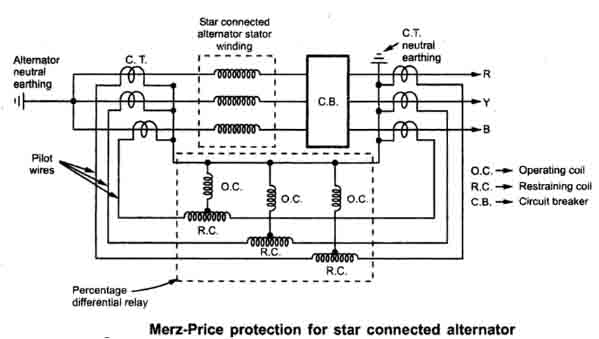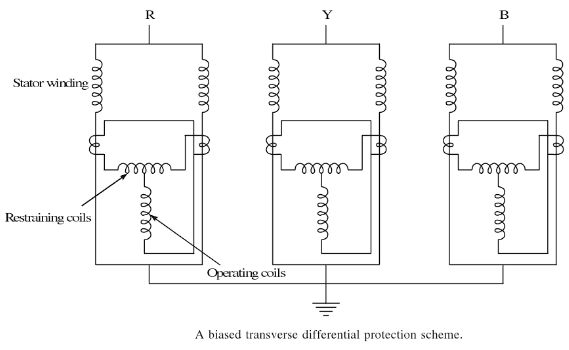100 MCQ OF Synchronous Generator or Alternator with Explanation
31.Which of the following factor should be identical for two alternators running in parallel?
Condition for parallel operation of an alternator
There are five conditions that must be met before when two alternators running in parallel.- Equal line voltage
- Same frequency
- Same phase sequence
- Same phase angle
- Same waveform
Same Phase sequence
- During the installation of a generator, carefully ensure the generator terminals and all control wiring is correct so that the order of phases (phase sequence) matches the system.
- Connecting a generator with the wrong phase sequence will result in a short circuit as the system.
- If we will connect any of the alternators with the opposite phase sequence then the voltages of both the alternator will become opposite to each other.
Same Frequency
- The frequency of two alternators should be the same otherwise it will cause high acceleration and de-acceleration in the prime mover hence this will result in large power transient in the power system.
Equal line voltage
- The line voltage of an alternator should be the same as the voltage of a bus bar.
- If the voltage on the alternator will be more than the bus bar than the generator will deliver unnecessary high reactive power to the grid.
- If the voltage of the bus bar is more than alternator than the generator will absorb high reactive power from the grid or busbar.
32.The main reason for the voltage drop in an alternator is
Voltage Drop due to Armature Resistance
- The voltage drop caused by armature resistance per phase is IRa Where I phase current in ampere and Ra is armature resistance in ohm.
- Additional energy loss such as Hysteresis loss, Eddy current Loss, and loss due to unequal distribution of currents are part of armature resistance losses.
Armature Leakage Reactance
- When the load current flows through the armature winding it builds up the local flux which cuts the winding and counters EMF is generated. This effect produces armature reactance that is equal to 2πfl.
- This armature reactance is called leakage reactance XL. and this leakage flux is proportional to the armature current.
Armature Reaction
- When the load current flows in the stator conductor it produces the magnetic field which has a cross-magnetization, de-magnetization, and magnetizing effect upon the main flux due to the field windings.
- Such an effect of armature current upon the main flux is known as armature reaction.
- The armature reaction depends upon the power factor of the load.
Synchronous Reactance.
- The combination of leakage reactance along with armature reaction is called as synchronous reactance.[/bg_collapse]
33.The maximum power in a synchronous machine is obtained when the load angle is
The maximum power which can be obtained from the synchronous machine for a power angle δ = 90 degree. Pm = EV/Xs × sinδ = EV/Xs × sin90o = EV/Xs For any other power angle power is given as P = Pm sinδ
Ads
34.The 3-phase unbalanced stator current in an alternator or synchronous machine cause
The main reason for unbalanced condition is
- When a fault occurs in the stator winding
- Open-circuiting of a phase
- Failure of circuit breaker contacts
- An unbalanced stator fault is not cleared quickly.
- The negative sequence component of unbalanced stator current causes double frequency current to be induced in the rotor iron.
- If this unbalanced component becomes too high this will cause overheating in the rotor part.
- Overheating of the rotor cause eccentricity which produces vibration in the motor.
35.In large synchronous generator or alternator, the protection provide for external fault is
Biased differential protection or Merz-Price Protection
- In this method, two sets of an identical current transformer are mounted on either side of the stator phase winding.
- The secondaries of the CTs are connected in star and their ends are connected through pilot wires.
- At normal operating conditions, the currents at the two ends of the protected section are the same ( I1 = I2).
- When the fault occurs the balance is disturbed and differential current ( I1 = I2) flows through the operating coil of the relay.

- This trip the generator circuit breaker to isolate the faulty section.
- The relay employed in this protection scheme is generally of electromagnetic type and is arranged for instantaneous operation as the fault is expected to be cleared as quickly as possible.
Sensitive Earth Fault Protection
- Sensitive Earth fault protection is normally used on systems where the earth fault current is limited to a very low value.
- For sensitive earth fault protection, one dedicated Core Balance CT is used to detect any unbalance in 3 phases and its setting is so low even less than 1 % so it's called sensitive earth fault protection.
Inter Turn Fault
- The coil used in the alternator is the multi-turn coil and the fault that occurs when there is a short that occurs between two turns in a machine winding which are close to each other is called inter-turn Fault.
- This fault occurs due to the current surge with a high value of (L × di/dt) voltage across the turns.
- Inter turn fault mostly occurs in the stator part of an alternator.
Stator Inter-Turn Fault Protection
- Inter-turn faults on the same phase of the stator winding do not disturb the balance between the current in the neutral and high voltage CT's.
- This is the reason why inter-turn fault cannot be detected by longitudinal differential protection.
- A biased transverse differential protection is used for protecting the inter-turns fault of the generator.

36.In an alternator, if the winding is short pitch by 60o electrical its pitch factor will be
Pitch factor Kp = cos α/2 α =60o Kp = cos 60/2 = cos 30 =0.866
37.Consider two alternators are running in parallel now if the excitation of the one of the alternator is changed then it will
- Suppose the excitation of the alternator is decreased below normal excitation then reactive power will change and active power output (W or KW) of the alternator will remain unchanged.
- The under-excited alternator delivers leading current to the infinite bus bar.
- It is because the leading current produces an adding m.m.f to increase the under excitation.
- Similarly, an overexcited alternator operates at lagging power factor and supplies lagging reactive power to an infinite bus bar.
38.The function of Potier triangle is to separate
- Potier triangle method is also called as Zero power factor (ZPF) method.
- According to this method in any alternator armature resistance drop IRa and the armature leakage reactance drop IXL are basically the e.m.f quantities while armature reaction is considered as m.m.f quantities.
- This method is based on the separation of the armature leakage reactance and armature reaction effect.
- The armature leakage reactance XL is called as Potier reactance hence this method is also called as Potier reactance method.
39.Overspeed protection of the generator is done by
- A governor, or speed limiter, is a device used to measure and regulate the speed of a machine, such as an engine.
- The main function of a governor on a generator to sense the speed deviation and adjust the power input( through opening or closing of valves on the steam unit).
- The governor will change the power input in proportion to the speed deviation.
40.The method of reducing the harmonic in an alternator is
Well distributed winding
- Instead of keeping the winding conductor concentrated, it is kept distributed and due to that there is a considerable reduction in 3rd harmonic at the cost of the slight decrease in induced emf.
Short Pitch winding
- Short pitching can be used to eliminate harmonics of a particular order in alternators.
- In full pitched coils, as one conductor of a turn in a coil cuts N pole, the other conductor of the same turn cuts S pole resulting in the production of induced emf(E).
- In short-pitched coils, both conductors of the same turn in a coil don't cut the respective poles simultaneously.
- As a result, the magnitude of induced emf gets reduced to E × Cos(nθ/2), where θ is the chording/short pitching angle ’n’ is an order of harmonic for which the effect of chording is being considered.
- Cos(nθ/2) is called the chording factor for ‘nth’ harmonic.
Skewing
- Slots are skewed in order to minimize the effect of voltage resulting from the ripple in the air gap flux produced by the stator slots.
- The effect of the number of slots that produce undesirable ripple voltage can be limited by some degree of skew.


No comments:
Post a Comment